
Introduction
This scenically beautiful province, ‘the land of the rising sun’ in the local siSwati and Zulu languages, is probably best known as the home (along with part of Limpopo province) of the Kruger National Park. It is a place of game, adventure and rich history.
'
Mpumalanga, is the place of the Rising Sun' and is the name given to the new province in Eastern Transvaal in 1993. It includes part of the old Transvaal and the former homeland KaNgwane, as well as parts of Gazankulu and Lebowa.
Top attractions

Kruger National Park
The Kruger National Park stretches across Limpopo and Mpumalanga. It's home to the Big Five (elephant, Cape buffalo, leopard, lion, rhino), and over 140 animal and 150 bird species. Expect good roads and excellent choice of accommodation to suit all pockets. Winter months (May to September) are best for game viewing as the vegetation is sparse and game easier to spot. Summer months (October to April) bring bird migrants back from their wintering north, and there are lots of baby animals.

Sabi Sand Reserve
The Sabi Sand, South Africa’s most famous private game reserve, borders the western Kruger National Park and has many superb, world-famous luxury lodges, including Mala Mala, Sabi Sabi and Londolozi. It is teeming with game and has the highest density of leopards in the world.

The Panorama Route
The Panorama Route is home to some of the most breathtaking scenery in the country, with famous landmarks such as the Blyde River Canyon, Bourke’s Luck Potholes and the Three Rondavels. It is easily accessible by vehicle, with great hiking trails and adventure activities.

Pilgrim’s Rest
Pilgrim's Rest is a historic village that remains much as it was in the turbulent gold-rush days of the 1870s.
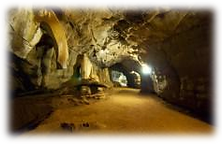
The Sudwala Caves
Thirty-five kilometers before Mbombela (formerly Nelspruit) and en route to the Kruger National Park from Johannesburg, are the oldest known caves in the world, formed about 240-million years ago. The Sudwala Caves are great for a short visit (tours leave on the hour), with spectacular rock formations older than Africa itself.
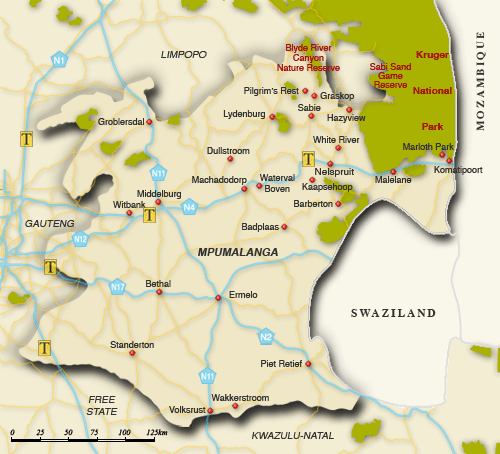



The ‘Genesis of Life’
The 3.5-billion-year-old rocks of the Makhonjwa Mountains outside Barberton are among the most ancient in the world and contain some of the first evidence of microfossil life on Earth.

Colourful cultures
The Shangana Cultural Village outside Hazyview gives an exciting first-hand experience of local life, culture and food. In Mpumalanga’s Cultural Heartland, at Botshabelo Historical Village near Middelburg, explore the culture of the Ndebele people and shop for eye-catching traditional arts and crafts.
Mpumalanga, ‘the land where the sun rises’, is in the east of South Africa, north of KwaZulu-Natal, and borders Swaziland and Mozambique.
OVERVIEW OF MPUMALANGA

Elephants – one of the Big Five animals that can be seen at the Kruger National Park
Mpumalanga is home to the Kruger National Park, one of the oldest, largest and most famous game reserves in the world. It is also home to the Sabi Sand Reserve, South Africa’s most prestigious private game reserve.
But it is also where you’ll find some of South Africa’s most dramatic scenery; more waterfalls than anywhere else in the country; mountains that cocoon Earth’s oldest life forms; the oldest dolomite caves in the world; colourful cultures; an exciting gold-rush past; friendly little towns; and adventure activities for the most adrenalin-hooked action junkie.
The province, which stretches east from Gauteng to neighbouring countries Swaziland and Mozambique, owes its spectacular scenery to its geographic location: about four hours’ drive north-east from Johannesburg, the Drakensberg mountains drop down steeply from the grasslands of the Highveld escarpment to the subtropical Lowveld savannah below.
The edge of the escarpment is home to the high, scenic Panorama Route that traces the course of the powerful Blyde River and takes in some spectacular natural attractions, as well the historic village of Pilgrim’s Rest, where you can relive the heady gold-rush days of the 1870s (and even pan for gold if you have time).
Four mountain passes wind down from the escarpment to a subtropical area of flourishing citrus and fruit farms, which then becomes 20 000km2 of the Kruger National Park.
Choose from any number of accommodation options ranging from charming, affordable B&Bs, to guest farms, country hotels and luxury game lodges.
Mpumalanga has an excellent infrastructure, with good roads that make self-driving easy, and lots of attractive small towns with restaurants and curio shops. It’s also South Africa’s top adventure center, where you can go river rafting, abseiling, climbing, quad biking, horse riding and mountain biking.
It’s no wonder, then, that Mpumalanga is one of South Africa’s top tourist destinations.
Game viewing
Game viewing in Mpumalanga is probably as good as it gets. The iconic Kruger National Park, about 350km from south to north along the Mozambique border and averaging 60km from east to west, is the size of a small country.
And that’s exactly how you’ll feel – that you’re in a unique country where wildlife rules, and nature shows off many spectacular Eco zones, from bushveld and mountains to savannah and forest. Choose between self-drive, guided game walks and drives, and wilderness trails.
The park is home to the Big Five (elephant, Cape buffalo, leopard, lion, rhino), and over 140 animal and 150 bird species.
Kruger’s neighbours to the west, Sabi Sand Reserve and other adjacent private reserves, are also teeming with game. Your chances of spotting the beautiful, elusive leopard here are very high as Sabi Sand has the highest density of leopards in the world. It is home to world-famous five-star lodges … but no day visitors.
Mpumalanga is home to the Kruger National Park, one of the oldest and largest wildlife reserves in the world.
Scenic Attractions
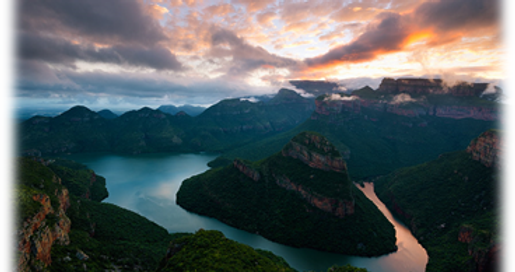
A view of the Blyde River Canyon
The Panorama Route, one of the highest and most dramatically scenic routes in South Africa, takes you to several splendid natural wonders as it traces the Blyde River.
The views from the 26km-long Blyde River Canyon, the world’s third-largest canyon (after the Grand Canyon in USA and the Fish River Canyon in Namibia), are superb, both from the bottom and the top, and are easily accessible by road or on foot.
A good way to take in as much as possible is an easy half-day’s drive on which you’ll see the Pinnacle – an enormous quartzite pillar; God’s Window – with seemingly unending views of the surrounding countryside (and a good place to buy curios); Bourke’s Luck Potholes, curious, deep rock pools named after an early gold prospector; and, at the end of the route, the Three Rondavels– massive rock formations resembling beehive huts with the Blyde River swirling hundreds of meters below. The view here is awesome in the full sense of the word.

Blyde River Canyon, Bushbuckridge, Mpumalanga
A 26km-long canyon (third-largest in the world) that offers superb views.

The Three Rondavels, Mpumalanga
Massive beehive-like rock formations that are an iconic feature of Mpumalanga.

Bourke’s Luck Potholes
These rock pools, a geological wonder, are named after an early gold prospector.
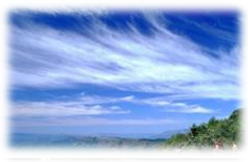
Motlatse Canyon Provincial Nature Reserve
God's Window
Aptly named vantage point that offers unending views of the surrounding countryside.
MAIN CENTERS

Mbombela (Nelspruit)
Mpumalanga’s capital city (previously called Nelspruit) started life in the 1890s as a hub for gold diggers, farmers and traders. It’s now a thriving commercial center and a shopping magnet for neighbouring countries Swaziland and Mozambique. Expect shopping malls, good restaurants and lively nightlife.

Barberton
Cradled by the Makhonjwa Mountains (a mecca for international scientists because of its microfossil plant life), this historic little town was born in the rowdy 1880s gold rush days and boasted South Africa’s first gold stock exchange. Heritage walks, working gold mines and adventure activities are on offer.

Hazyview
As its name suggests, this little town is often surrounded by mountain mists. Its proximity to two of the Kruger National Park gates makes it a good place to stock up on groceries and supplies before entering the park. There’s an aerial cableway and the visitor-friendly Elephant Sanctuary just outside the town.

Sabie
Situated in the heart of the Panorama Route, and in the middle of one of the world’s biggest man-made forests
(450km2 of pine and eucalyptus trees), this busy small market town, which once depended on gold, now derives its wealth from timber. It's close to the Kruger National Park and magnificent waterfalls.
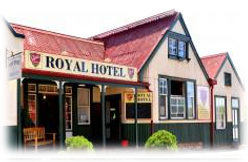
Pilgrim’s Rest
This village was once the center of the 1870s gold rush. You’ll see many of the original buildings, like the Royal Hotel, the general store and the newspaper office (where the Irish editor kept a pair of loaded pistols on his desk), as you walk up the steep hill to the village.
Timeline
Mpumalanga is a top tourist destination because of its spectacular scenery and lots of adventure activities.

3.5-billion years ago
'Genesis of Life’: The 3.5-billion-year-old Makhonjwa Mountains in Barberton are among the oldest in the world, and contain Earth’s first microfossil evidence of life.

1000-5000 years ago
Late Stone Age San hunter-gatherers leave rock paintings and engravings (about 1000-5000 years ago).

1000AD - 1300AD
Small nation states build stone kingdoms and engage in trade.

1870's
Gold is discovered, and thousands of hopeful diggers flock to the area. This is the era of 'Jock of the Bushveld', a dog made famous in a book of this name by Sir Percy Fitzpatrick.

1898
The Sabi Game Reserve, the forerunner to the Kruger National Park, is established in 1898 by president of the then-South African Republic, Paul Kruger.
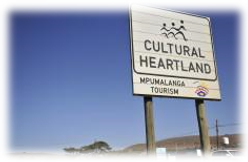
1995
Formerly the Eastern Transvaal, the province is renamed Mpumalanga.
Mpumalanga is home to colourful cultures and visitor-friendly cultural villages.
Tips for our dESTINATION eVENTS travellers

Drivers keep left to let an elephant pass near the Satara Bush Camp in the Kruger National Park
-
A guided game drive in the Kruger National Park is a must. Book when you check in. Choose a sunset drive over all others because you go out in daylight, watch the sun set as the game drink at waterholes, then, as darkness falls, you experience a thrilling night drive by spotlight.
-
Satara Rest Camp in the middle of Kruger is not the most beautiful camp, but it sits in the middle of the best game-viewing areas of the park. All the main camps are child-friendly with pools.
-
Early booking for the Kruger National Park is essential. Bookings open 11 months in advance. If you can, try to avoid school holidays (July, August, December, early January) as accommodation is more difficult to obtain. Book by phone rather than online.
-
Malaria medication is a must in the Lowveld. Check with your doctor prior to your visit.
-
Safari essentials – whether self-drive or guided – are a good pair of lightweight binoculars, camera, sunhat, sunscreen, bug spray, comfortable walking shoes and water.
-
If the budget allows, for your self- drive safari, rent an SUV or combi/van. You’ll have more legroom and an even better chance of spotting game because you sit high up. Book well in advance.
-
Choose individual specialised field guides on mammals and birds rather than a general one. Camp shops sell them, or do some homework before your trip.
-
If you want that ‘special’ gift or souvenir, buy bead-craft from roadside vendors or curio shops. In Barberton, you can buy hand-designed gold jewellery made from the oldest gold in the world, next to the Barberton Museum.
-
Fruit and nuts from roadside farm stalls are always a good buy.
-
The standard universal greeting in South Africa is, ‘Hello, how are you?’
Mpumalanga has an excellent infrastructure with good roads and lots of different accommodation options.
